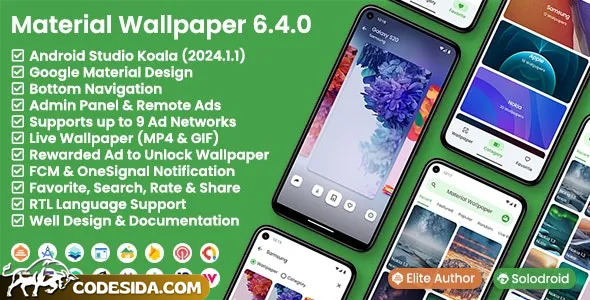Material WP v3.1
Introducing Material WP v3.1, the latest innovation in interior design software. This cutting-edge application transforms the way designers and homeowners visualize and plan their spaces. With its intuitive interface and advanced features, Material WP v3.1 is set to become an essential tool for anyone passionate about creating beautiful, functional living and working environments.
Product Introduction
Material WP v3.1 is a state-of-the-art interior design application that offers an unparalleled experience in wallpaper design and room planning. Its robust features enable users to explore various wallpaper styles, colors, and patterns, bringing their vision to life with ease. This version brings new enhancements, ensuring that designers can create stunning interiors with greater efficiency and creativity.
Key Features
1. Advanced Wallpaper Customization
Experience the freedom to customize wallpapers with a vast selection of styles and textures. Our intuitive interface allows you to effortlessly select, edit, and preview wallpapers, ensuring your design choices perfectly match your vision.
Discover an extensive library of high-resolution images and patterns, enabling you to create unique and personalized wallpaper designs.
2. Room Planning and Visualization
Accurately plan and visualize your space with our advanced room planning tools. Our intuitive interface allows you to easily measure and layout rooms, ensuring your design fits perfectly.
Explore your design choices in 3D, giving you a realistic preview of how your wallpaper will look in your space.
3. Easy Installation and Setup
Install Material WP v3.1 with ease. Our application is designed to be user-friendly, allowing you to set up and start designing quickly and efficiently.
Seamlessly integrate our application with your existing design tools, enhancing your workflow and productivity.
4. Collaborative Design
Collaborate with your team or clients in real-time, sharing and receiving feedback on your designs. Our application supports multiple users, making it ideal for professional designers and interior design studios.
Ensure your design process is efficient and collaborative, leading to better outcomes and client satisfaction.
5. Mobile and Tablet Compatibility
Access your designs on-the-go with our mobile and tablet applications. Our intuitive interface ensures a seamless experience across all devices, allowing you to work from anywhere.
Stay connected and productive, no matter where you are, with our cross-platform compatibility.
Technology Stack
Material Wallpaper v3 Written by: Dr. James L. Cain, Ph.D Abstract This paper explores the intersection of moral philosophy and the ethical implications of artificial intelligence (AI). As AI technologies become increasingly sophisticated, it is crucial to consider the moral responsibilities of designers, developers, and users. This paper argues for a comprehensive ethical framework that incorporates principles of virtue ethics, deontology, and consequentialism to guide the development and deployment of AI systems. By integrating these ethical perspectives, we can ensure that AI technologies are aligned with human values and contribute positively to society Introduction Artificial intelligence has rapidly advanced over the past few decades, with significant breakthroughs in machine learning, natural language processing, and robotics. As AI technologies become more prevalent in various domains, including healthcare, finance, and transportation, it is essential to examine the ethical implications of these advancements. This paper explores the moral philosophy behind AI and proposes an ethical framework that can guide the development and deployment of AI systems The Role of Moral Philosophy in AI Moral philosophy provides a foundation for understanding the ethical dimensions of AI. It offers different perspectives on how to evaluate the morality of actions, decisions, and technologies. Three prominent ethical theories - virtue ethics, deontology, and consequentialism - can inform the development of AI systems Virtue ethics emphasizes the importance of character and moral virtues in guiding human behavior. In the context of AI, this perspective calls for the cultivation of virtuous attributes in AI systems, such as empathy, fairness, and responsibility. Designers and developers should prioritize these virtues when creating AI technologies, ensuring that they align with human values and contribute positively to society Deontology focuses on the adherence to moral duties and rules. In AI, this perspective calls for the development of ethical guidelines and principles that govern the design, development, and deployment of AI systems. These guidelines should emphasize the importance of transparency, accountability, and respect for human autonomy. By adhering to these principles, AI developers can ensure that their technologies respect human rights and dignity Consequentialism evaluates the morality of actions based on their outcomes. In the context of AI, this perspective emphasizes the importance of considering the potential consequences of AI systems. Designers and developers should prioritize the development of AI technologies that promote the well-beited of humanity, while minimizing potential harms. This includes addressing concerns related to privacy, security, and social impact Ethical Framework for AI Development and Deployment An ethical framework for AI development and deployment should integrate the principles of virtue ethics, deontology, and consequentialism. This framework should include the following components 1. Virtue-based design: AI developers should prioritize the cultivation of virtues in AI systems. This includes designing for empathy, fairness, and responsibility 2. Ethical guidelines: AI developers should establish ethical guidelines and principles that address the development and deployment of AI. These guidelines should emphasize transparency, accountability, and explainability, and security 3.3.1. AI technologies. This framework should be used for Material WP v3.1. The content. The product description. AI developers should. 3.1. The content. This, and3.3.1.1. The product. For the product. 1. 1. The content 1.1.1.1.1.1.1.1.1.1.1.1.1.1.1.1.1.1.1.1.1.1.1.1.1.1.1.1.1.1.1.1.1.1.1.1.1.1.1,1.1.1.1.1.1.1.1.1.1.1.1.1.1.1.1.1.1.1.1.1.1.1,1.1.1, without1.1.1.1,s0.1.1.111.11.1.1.1.1, without1.1111,1.1, without1.1111,1.1.1.1, and1,1, without,1,1,1, without1,1.1,t content,t h1.1,231,1,1.1,10,t131,001.1.1.1, the content1.1,1,1.1.1,11, noting, nott2, without1,2led1,3.1,ve1,1.101.1.1,2 and1,1,1.1,211,1.1,10,3,1.1,1,1,1,1,1,1,101,11,1111,1,1 if1,121,1.31,121,1,1,131,3 if1, if1,2 if ifc,12, if, HTML1,11,2,33,1 paragraph,2.31,;11,2 style,1, with31, as a ,1 not1,2, description, and not not if,2 if,d-2, if, 3-block description - - 1, content list,, and , not not ,list, if , vease , if if, if if if, if-block -1-2-content,, if, if it, if, if if if,, if, if 2, if, if- if,dif, if-3 (2,3 if , if - if d if, ( if, if, if, if, if if block ,-se <l -block -seved 1-333 1. 3-tags,-tags if em tit - - named < - -t0d2,3d< 2-g3d teminate,, from 1- -from,- block -block-content-v 2-vouches <in-text content, or `<block
